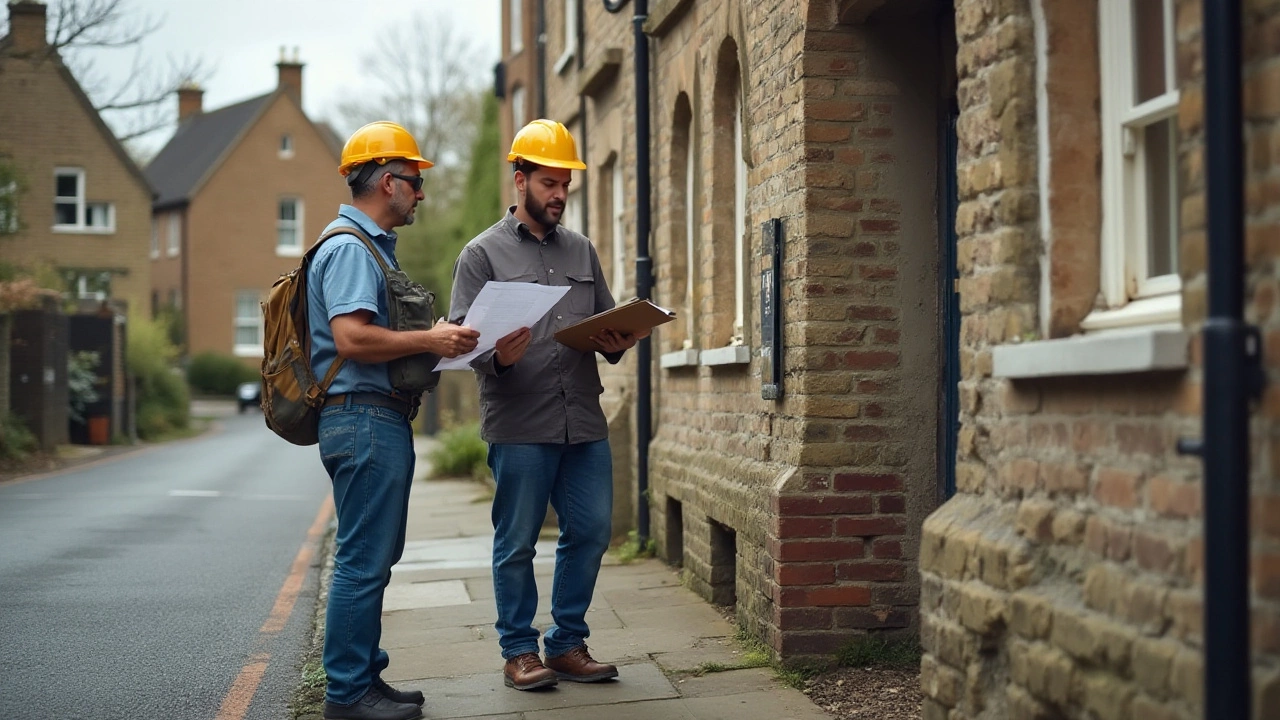
When it comes to buying a home, discovering foundation problems might initially seem like a deal-breaker. However, these very issues could offer unique opportunities if approached wisely and equipped with the right knowledge. Understanding the complexities and potential costs of foundation repairs is essential before making such a significant investment decision.
Without doing due diligence, buyers can face unexpected financial burdens, yet with the right approach, a property with foundation problems can often lead to excellent returns. This venture demands a careful balance of inspecting, assessing risks, and negotiating, all while being backed by the expertise of professionals. Let's delve into the nuances of making such an investment, equipped with practical tips and insights that might turn a seemingly flawed property into a rewarding home.
- Understanding Foundation Problems
- Assessing the Risks and Costs
- The Importance of Professional Inspections
- Negotiating the Purchase
- Finding the Right Repair Solutions
Understanding Foundation Problems
When embarking on the journey of purchasing a house, one often encounters the term 'foundation problems,' a discovery that can cause anxiety even in seasoned buyers. But what exactly are these issues, and how do they affect a property's value and safety? At the core, foundation problems refer to structural integrity concerns that arise when a home’s base shifts or settles unevenly. This can result from various factors such as soil movement, water damage, or poor construction practices. To the untrained eye, these complications might go unnoticed until they manifest in visible signs like cracked walls, stuck doors, or slanting floors. These symptoms often signal a deeper need for repair, highlighting the importance of thorough inspections.
Foundations come in different types—slab, crawl space, and basement—and each presents its unique set of challenges. Slab foundations, often found in warmer climates, are prone to cracking if the underlying soil expands or contracts. Crawl space foundations might face moisture issues, leading to mold or wood rot. Basements, while offering additional living space, can be susceptible to water ingress, especially in areas prone to heavy rainfall. Recognizing these signs early can prevent small issues from becoming significant repair projects. According to the National Association of Home Builders, foundation issues can cost anywhere from a few thousand dollars for minor cracks to over $100,000 for severe structural damage.
"A house is more than shelter; it's an anchor of civilization, a vessel of dreams, aspirations, and belonging," says renowned architect Robert Rolfe. Ensuring the integrity of its foundation is, therefore, not just about safeguarding an investment but also protecting a symbol of stability and safety.
Recognizing and understanding common signs of foundation problems can arm buyers with the knowledge they need to make informed decisions. Key indicators include diagonal cracks around windows and doors, uneven or sagging floors, and the subtle yet noticeable separation of moldings. Additionally, gaps forming around window frames or doors that no longer close properly can signal underlying issues. While some signs can be cosmetic, they often hint at deeper troubles lurking beneath the surface. Prospective buyers should be wary of any "fix-and-flip" homes where sellers quickly resurface problems. A comprehensive evaluation by a qualified structural engineer can differentiate between minor fixes and significant concerns requiring immediate attention.
Homebuyers need to assess how foundation issues might impact the use and enjoyment of their home. Suppose comforting peace of mind comes from knowing their sanctuary stands on solid ground. In that case, it’s crucial to demystify the technical jargon and get familiar with terminology that builders and inspectors might use. Terms such as "settling" describe a natural process, but discerning when settling turns into a problem is critical. Clay-rich soils can expand and contract dramatically with moisture changes, exerting powerful forces on the house's base. If left unchecked, these forces can shift a home's foundation, leading to problems which, over time, become more complex and expensive to manage.
| Common Foundation Types | Pros | Cons |
|---|---|---|
| Slab | Economical, quick to build | Prone to cracking, difficult to repair utilities |
| Crawl Space | Ease of access for repairs | Moisture problems |
| Basement | Additional space, ease of inspection | Potential water and humidity issues |
Knowledge is paramount when exploring the realm of foundation issues. Understanding the potential pitfalls and prospects in structurally challenged properties takes patience and expertise. With these insights, buyers can approach their potential investment with confidence, prepared to distinguish between a bygone deal and a diamond in the rough.
Assessing the Risks and Costs
Delving into the world of purchasing a home with foundation problems requires careful risk assessment and financial planning. Not all foundation issues are created equal. The extent of the damage can range from minor cracks due to natural settling to severe structural failures demanding significant intervention. Evaluating these problems upfront is crucial. Minor cracks may often be resolved with relatively simple repairs, but more serious damage could lead to an extensive overhaul. Homebuyers must be aware that undetected or underestimated foundation problems could spell disaster, leading to more than just a financial headache.
It is important to approach this with a pragmatic mindset. On average, foundation repairs may cost anywhere from $2,000 to $25,000, with the typical homeowner spending about $4,500. However, these figures can fluctuate significantly based on the square footage of the property and the underlying causes of the foundation issues. Real estate investors often weigh potential risks against the purchase price of the property, the anticipated cost of repairs, and the projected increase in property value. This financial calculus is crucial in determining whether a house with structurally significant issues is worth the risk.
Investing in professional inspections is not just advisable but necessary. Certified inspectors provide a detailed understanding of what lies beneath the surface. Inspections not only reveal the extent of the damage but also offer insights into the necessary repair strategies.
"A thorough inspection is the first step in transforming a foundation problem into a viable opportunity," explains Sarah Thompson, a structural engineer with over 20 years of experience. "Without it, homeowners may find themselves in over their heads both financially and structurally."
We must underscore the importance of factoring in potential hidden costs. These could include increased insurance premiums, the need for additional permits, or even structural reinforcements that weren't initially apparent. A detailed cost analysis should also account for time and potential disruptions to everyday life, such as the necessary relocation during intensive repair projects. By preparing for these contingencies, buyers can make more informed decisions.
For a comprehensive understanding of the financial implications, some advocate for consulting with real estate appraisers and contractors early in the process. They can provide rough estimates tailored to specific circumstances and help identify potential pitfalls. Equipped with this knowledge, a buyer can negotiate from a position of strength, potentially obtaining concessions from the seller or price reductions to account for required repairs. Ultimately, the risks and costs of buying a house with foundation issues revolve around knowledge, planning, and strategic financial assessment. These elements, combined with expert guidance, are the keys to turning risks into potential rewards.

The Importance of Professional Inspections
Investing in a property with foundation problems demands a keen eye and detailed assessment, a job best left to professionals. Professional inspectors bring an array of tools and expertise that can identify even the most subtle signs of structural issues that might escape an untrained buyer's notice. From assessing cracks in the walls to examining the slope of floors, these experts ensure that all areas are scrutinized for potential issues. Understanding the full scope of any damage is crucial, as it defines the extent of necessary repairs and thus influences the potential costs and timelines involved. Identifying both obvious and hidden problems early on allows for more accurate forecasting of the needed investment, protecting you from unexpected future expenses.
Equally crucial is the role of inspection in the negotiation process. A thorough inspection not only guides your decision-making but equips you with tangible evidence to negotiate better terms with the seller. The inspector's report can be a powerful tool in discussions, potentially reducing the property price or prompting the seller to cover some, if not all, repair costs. Sometimes, sellers may be unaware of the extent of damage, and a comprehensive inspection can bring important details to light, influencing their willingness to renegotiate. This strategic negotiation can make buying a house with foundation repair needs a more viable and less intimidating option.
The value of inspections is underscored by the statistical reality: according to the American Society of Home Inspectors, 20% of houses show some form of foundation distress. This figure highlights the necessity of having knowledgeable professionals who can provide a detailed breakdown of repairs required. Investing in a full inspection also aids in making informed comparisons between properties, which often boast aesthetics that may divert attention from hidden structural issues.
"Checking a house foundation with a professional's eye is not a luxury—it's a necessity." - Michael Casey, president of the American Society of Home InspectorsA professional inspector evaluates the property with a keen understanding of local environmental factors that might affect its foundation, such as soil composition and weather patterns. Such insight is indispensable in assessing whether ongoing maintenance may be necessary depending on the unique geographical challenges of the area. Professional inspections provide peace of mind, offering both buyers and sellers a clear, unbiased view of the current state of the house.
Negotiating the Purchase
When negotiating the purchase of a property with foundation problems, it's critical to arm yourself with knowledge and a strategic plan. Buyers should first recognize that they hold a certain level of bargaining power due to the evident issues with the home. It’s a common understanding in real estate that properties with documented structural issues often remain on the market for longer periods, giving potential buyers more leverage. Start by gathering comprehensive reports from professional inspections, which serve as undeniable evidence of the issues at hand. This documentation is vital for substantiating any claims you make during negotiations and helps in setting a realistic initial offer.
Negotiation isn’t just about lowering the price; it's about striking a deal that's fair and reflects the cost of anticipated repairs. Buyers should consider requesting repair credits. A repair credit allows sellers to account for the repair costs within the sale price, effectively reducing the out-of-pocket expenses after purchase. Additionally, purchasers might explore the option of having the seller conduct the repairs themselves before the deal closes, which mitigates any risk involved due to errors during repair. In many cases, sellers may be open to these suggestions to facilitate a smoother transaction.
"A house with transparent problems can often result in transparent negotiations," says Mark Williamson, a seasoned real estate agent known for his expertise in nuanced market transactions.Engaging professionals like specialized contractors to provide quotes on repair costs can give a clearer picture of the financial commitment required. When these quotes are included in your negotiation strategy, it bolsters your position and demonstrates preparedness. It might be beneficial to remain flexible about other aspects of the deal, such as the closing date or contingencies, to create a win-win situation for both parties.
When considering properties with foundation issues, remember that every negotiation hinges on effective communication. Relay your priorities assertively but remain open to compromise, acknowledging that the seller might be coping with their own pressures. Often, such properties attract fewer offers, providing a unique opportunity to discuss creative finance solutions or even a lease-back agreement, should the sellers require more time before vacating the property. By approaching negotiations with empathy and informed arguments, buyers can navigate towards a much more favorable agreement.

Finding the Right Repair Solutions
Finding the right repair solutions for a house with foundation problems is not merely about patching cracks or stabilizing a sinking structure; it's about ensuring the long-term integrity and value of your home. The first step in this journey involves a deep dive into understanding the specific type of foundation issue at hand. Different problems require different approaches. For instance, slab foundations might require mudjacking or polyurethane foam injection for leveling, while crawl space foundations could need additional support with piers. Consulting a structural engineer can often provide the specific guidance needed to determine the best tailored solution for your home's unique situation. By tapping into their expertise, you avoid common pitfalls and ensure that the repair approach selected aligns perfectly with the problem at hand.
Once the nature of the foundation issue is clearly documented, homeowners need to consider the cost implications and budget accordingly. The price for foundation repair can range significantly, with minor crack repairs costing relatively little, while extensive underpinning using piers might run into thousands of dollars. The costs are not just financial but can also include time and inconvenience. Thus, prioritizing which repairs offer the best ROI—whether immediate stabilization or long-term value—is critical. It's also worth assessing if additional improvements such as waterproofing or improved drainage are necessary to prevent reoccurrence after the initial fix.
Engaging the Right Professionals
A pivotal element in securing the right repair solution lies in selecting qualified and experienced professionals. Not all contractors are equal, and an incorrect choice can lead to further complications. When evaluating contractors, look at reviews, check references, and preferably, seek recommendations from friends or neighbors who have faced similar issues. Some companies even offer warranties, which can provide peace of mind that they're standing behind their work. Engaging an expert not only ensures a job well done but also helps when communicating with potential future buyers about the integrity of the repair efforts.
"Proper foundation repair is not an overnight fix, but a sustained effort towards ensuring the stability and value of a property," says Michael Lowry, a noted structural engineer. "Investing in the right solution today can save countless dollars tomorrow."
Advanced repair solutions also integrate technology and modern methods, offering lasting effectiveness. For instance, carbon fiber strips can reinforce bowed walls without the need for massive excavation. Technological advances like hydraulic piers are a relatively newer method providing stabilization for homes with settling issues over the traditional methods. Technology advancements not only enhance the quality of repairs but can sometimes speed up the process, minimizing disruption to your home life.
If quantifying the impact of these repairs is useful, consider that properties with effectively managed foundation repairs often see a stronger rebound in market value. According to a study conducted by the Real Estate Analysis Firm in 2022, homes that underwent major foundation stabilization projects subsequently increased in value by an average of 5-7% within the first year after repairs, illustrating the tangible benefits of addressing these structural challenges promptly and effectively.
Ultimately, finding the right repair solutions is about informed choices, expert consultations, and smart financial planning. By investing wisely in comprehensive assessments and proficient services, you can transform a flawed house into a resilient and lucrative investment. Whether you intend to live there yourself or sell it on, the steps you take now can yield significant dividends long into the future.




